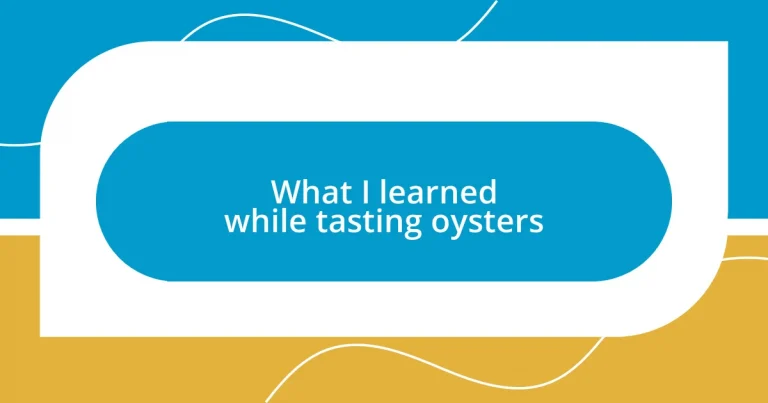Key takeaways:
- Oyster flavors vary significantly based on environmental factors like salinity and temperature, leading to unique tasting experiences for each variety.
- Freshness indicators include smell, shell status (closed or slightly open), and knowledge of the harvest date, all crucial for a delightful oyster experience.
- Sustainable oyster farming benefits marine ecosystems and supports healthier ocean practices, highlighting the importance of eco-friendly choices in seafood consumption.

Understanding oyster varieties
Diving into the world of oyster varieties is like embarking on a culinary adventure. Each type, whether it’s the briny Eastern or the sweet Kumamoto, carries its own unique profile shaped by its environment. I still remember tasting my first Kumamoto, and the gentle, fruity notes danced on my palate, making me question: how could something from the sea evoke such sweetness?
As I explored different regions, I learned that the water’s salinity and temperature define the flavor of oysters. For instance, oysters from colder waters tend to be more robust and crisp, whereas those from warmer climates can be creamier and softer. The first time I savored an oyster from the Pacific Northwest, it was as if the essence of the rugged coastline had been captured in that shell. Isn’t it fascinating how location influences taste?
What surprised me the most was the sheer variety within just one type; take the Blue Point, for example. While they have a strong, saline flavor, each batch can vary dramatically depending on the time of year and where they’re harvested. Have you ever experienced a distinct difference in flavor during a single meal? That’s the beauty of oysters—each bite is a new experience reflecting nature’s whims.
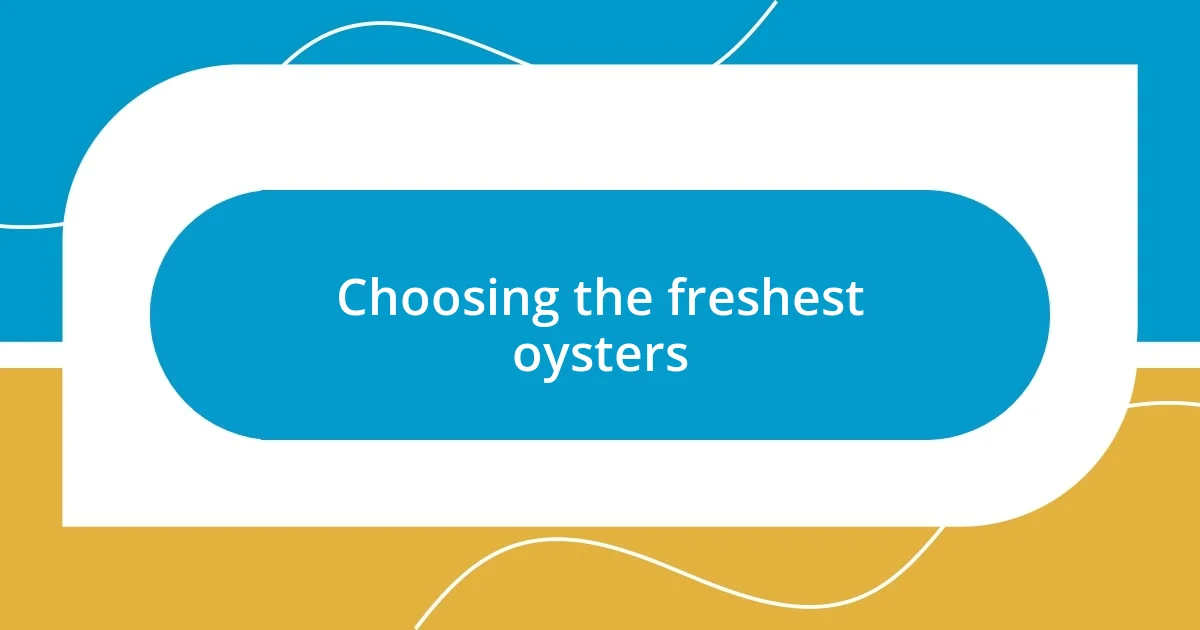
Choosing the freshest oysters
Choosing the freshest oysters involves more than just picking a few shiny shells off the ice. When I first started, I didn’t realize the importance of checking for odors. Fresh oysters should smell like a clean ocean breeze; if they have a strong fishy scent, it’s often a sign they’ve been sitting around too long. Imagine the disappointment of pulling back the shell only to encounter an unappealing whiff!
As I became more attuned to the nuances of freshness, I noticed that the shells should be tightly closed or just slightly open. A tightly closed shell often indicates a live oyster, while an open one that doesn’t close when tapped is a definite red flag. I recall my first trip to a bustling seafood market where I learned this the hard way—those open shells were from oysters that had long lost their vitality. It’s a quick test that can save you from an unpleasant experience, trust me!
Lastly, I learned to ask questions about the oysters’ harvest date. Many vendors will provide you this information, and it’s crucial. The fresher the oyster, the better the flavor, and it brings a delightful satisfaction knowing that you’re eating something just out of the water. During a family trip to the coast, we visited a local harvesting farm, and the excitement of enjoying oysters that had been pulled from the sea just hours prior was unforgettable. It’s a direct connection to the ocean that adds to the overall experience.
| Freshness Indicator | Description |
|---|---|
| Smell | Should smell like the ocean; strong fishy scent is a no-go. |
| Shell Status | Tightly closed or slightly open; open shells that don’t close are often dead. |
| Harvest Date | Asking for the harvest date ensures you’re enjoying the freshest oysters. |
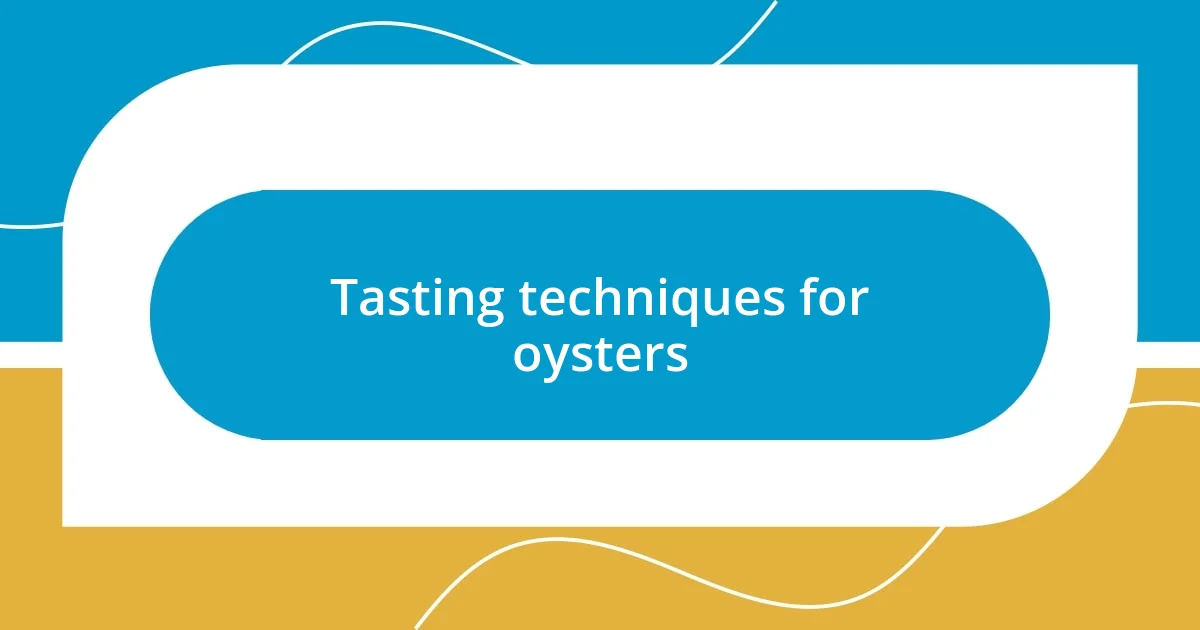
Tasting techniques for oysters
Tasting techniques for oysters
When it comes to tasting oysters, I quickly learned that the experience goes beyond a simple bite. The first time I accompanied a friend to an oyster tasting, I was surprised by how much attention we paid to the act itself. We observed each oyster’s appearance, taking in their shimmering shells and the liquid within. I remember feeling a surge of excitement as we dove into the flavors, each one a small adventure waiting to unfold.
To truly appreciate the tasting process, I recommend trying the following techniques that have enriched my own experiences:
- Look: Observe the shell for freshness—bright and shiny indicates a healthy oyster.
- Smell: Breathe in gently; the aroma should be reminiscent of the sea, fresh and briny.
- Slurp: Don’t be shy! Slurping helps to mix the oyster with air, enhancing its flavors and textures.
- Taste: Let it sit on your palate for a moment. Roll it around your tongue to catch all the notes, from salinity to sweetness.
- Pair: Experiment with different accompaniments like lemon juice or mignonette; they can elevate the tasting experience.
During one memorable tasting at a cozy local bar, I paired my oysters with a hint of horseradish and an icy shot of vodka. The bracing heat of the horseradish juxtaposed with the cold drink created a burst of sensations that lingered in my memory. It’s all about finding those lovely combinations that make each tasting unique!
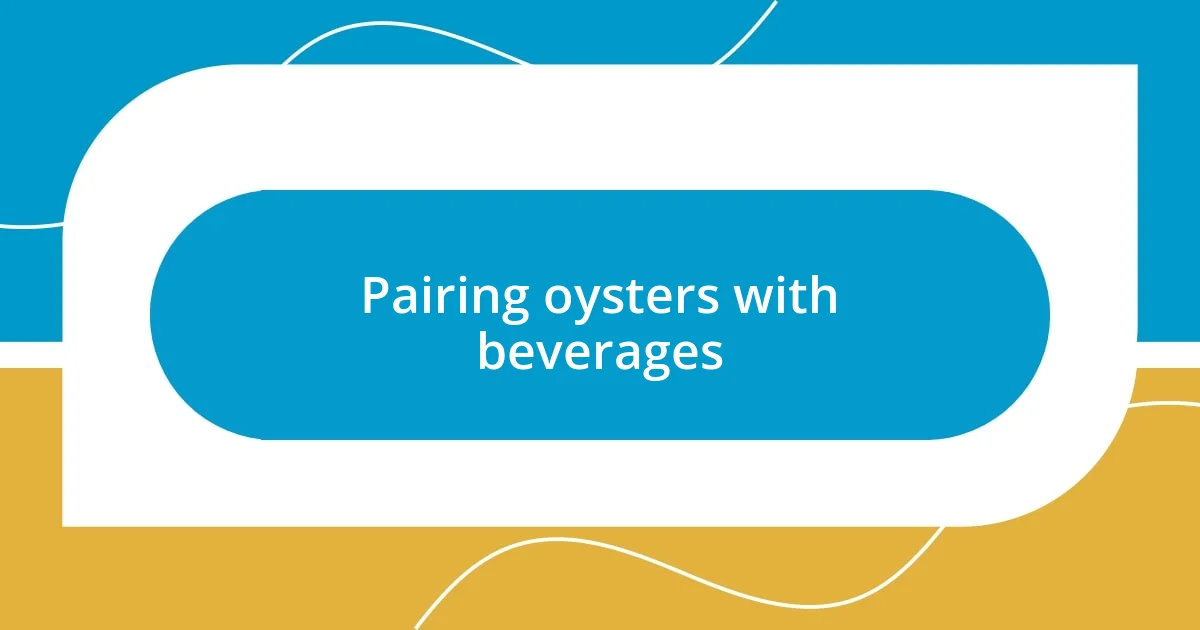
Pairing oysters with beverages
When it comes to pairing oysters with beverages, I find the right choice can elevate the entire tasting experience. I remember one particular afternoon when I was at a small seaside shack, sipping on crisp Sauvignon Blanc while savoring fresh Kumamoto oysters. The wine’s zesty acidity perfectly cut through the oysters’ creamy texture, creating a harmonious balance that danced on my palate. Isn’t it incredible how a simple glass of wine can transform your enjoyment?
In my experience, the adventure doesn’t stop with wine. Craft beers, especially those with light and fruity profiles, also make fabulous companions. One time, my friends and I tried pairing oysters with a local IPA. It was fascinating to see how the hoppy bitterness contrasted with the salty sweetness of the oysters. Have you ever thought about how different flavors can interact in unexpected ways? This experience not only expanded my palate but also introduced me to new beverage possibilities I hadn’t previously considered.
Let’s not overlook cocktails either! I once enjoyed oysters with a spicy Bloody Mary, and the bright acidity from the tomatoes alongside a kick of horseradish added a layer of excitement that was simply unforgettable. Can you picture the thrill of discovering such a vibrant pairing? It’s these little surprises that make tasting oysters an exhilarating journey. Every choice—from the drink to the oyster—creates a unique story to savor.
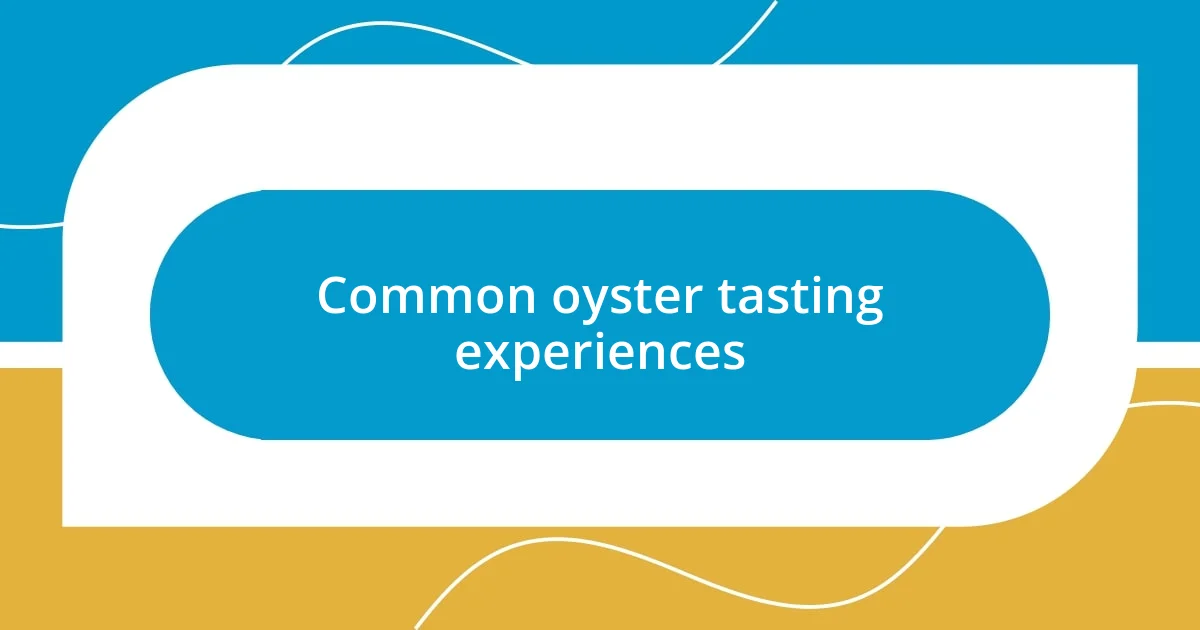
Common oyster tasting experiences
Oyster tastings often stir up a whirlwind of sensations, and one common experience I found was the sheer range of textures. I remember the first time I slurped down a chilled Pacific oyster. It was like a soft caress on my tongue, contrasting with the briny burst it delivered. Have you ever noticed how oysters can feel both delicate and robust at the same time? That complexity keeps me coming back for more.
Another fascinating aspect I’ve encountered is the variety of flavor profiles, especially the unexpected notes that can emerge. One evening, while sampling some tiny, sweet Beausoleil oysters, I was taken aback by a hint of cucumber—refreshingly light and subtly crisp. This doesn’t happen often, and moments like that make you appreciate the artistry behind each oyster. How often do we stop to ponder the flavors we take for granted?
The social element of oyster tastings also adds a unique layer to the experience. Sitting around a table with friends, each one sharing their favorite picks and combinations, always creates an atmosphere of excitement and camaraderie. I recall a lively evening where we each brought a different variety to share, and in that exchange, we discovered new favorites together. Isn’t it amazing how food can act as a delightful bridge between people, fostering connection and shared memories?
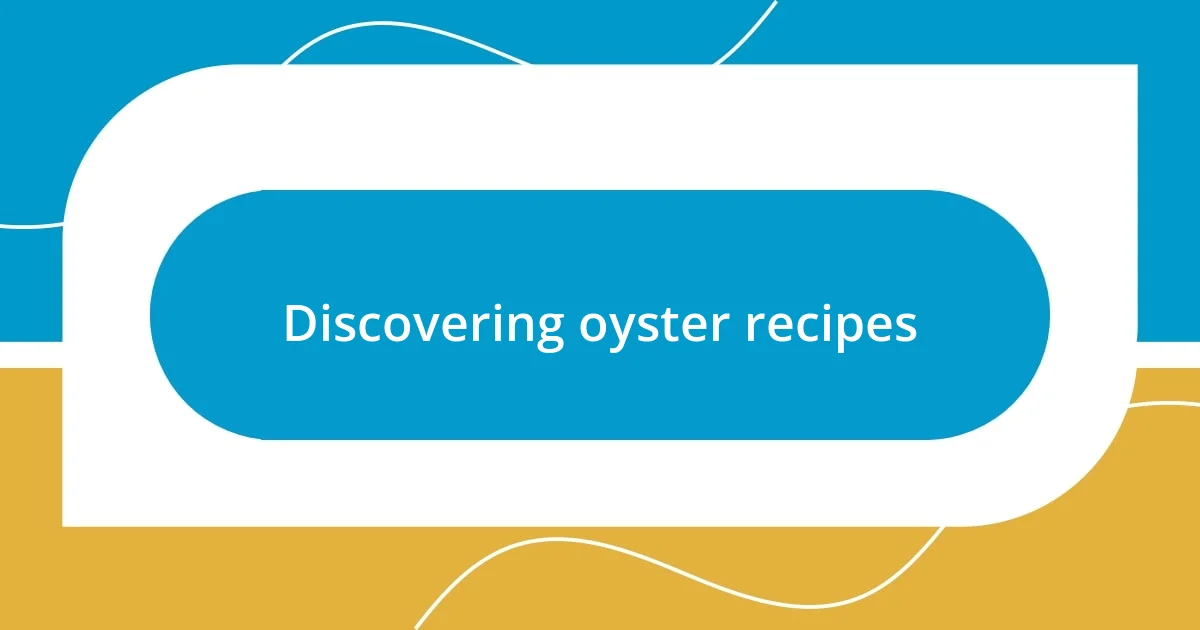
Discovering oyster recipes
When it comes to oyster recipes, I’ve stumbled upon some delightful surprises that truly showcase the versatility of these ocean gems. One particular recipe that stands out is grilled oysters topped with a garlic butter and Parmesan blend. I vividly remember the first time I took a bite. As the heat transformed the briny meat into a smoky, savory delight, I could hardly believe how a simple cooking method could enhance the oyster’s natural flavors. Have you ever considered that grilling can completely alter your perception of a familiar dish?
Another recipe I’ve tried that blew my mind was oysters on the half shell with a zesty mignonette sauce. The sharpness of the vinegar and the crunch of diced shallots brought a fresh twist that made each oyster feel like a burst of oceanic joy. In that moment, I felt connected to the sea as the flavors danced together. Do you think it’s possible for food to take us on a journey like that?
I also can’t resist the charm of oyster stew. The creamy broth infused with herbs wraps around the tender oysters, creating a comfort food experience that’s hard to beat. I can recall curling up with a warm bowl on a rainy evening, the fragrant steam filling the air as I took my first spoonful. Isn’t it interesting how food can evoke such strong memories and emotions? Each recipe not only highlights the oyster itself but also allows us to explore our culinary creativity, making every dish we prepare an exciting adventure.
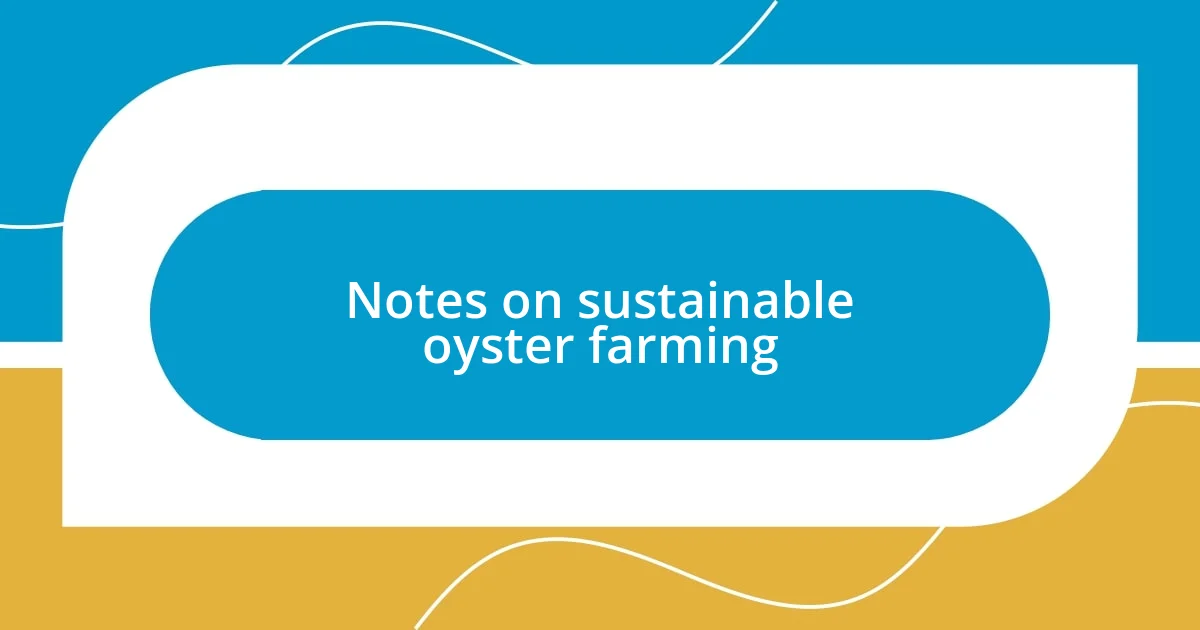
Notes on sustainable oyster farming
Sustainable oyster farming holds a special place in my heart, especially when I see the positive impact it has on marine ecosystems. I once visited an oyster farm that practiced restorative aquaculture, where the farmers genuinely cared not just about their harvest but also about the surrounding environment. It was enlightening to learn how oysters filter water and improve water quality, a necessity for vibrant marine life. Isn’t it remarkable how one species can contribute so profoundly to its habitat?
I remember one sunny afternoon speaking with a farmer who was passionate about focusing on eco-friendly practices. He explained how their method minimized chemical use and emphasized natural spawning, creating a healthier population of oysters. Listening to him, I felt a sense of hope – our choices matter. Have you ever considered how supporting sustainable practices in our food can lead to meaningful changes in the world?
Moreover, being part of a community that champions sustainable farming practices is a nourishing experience. At a local seafood festival, I had the chance to taste oysters while chatting with advocates of sustainable seafood. Their enthusiasm was contagious, and I found myself eager to share their message with others. Isn’t it empowering to know that our food choices can promote healthier oceans for future generations?












